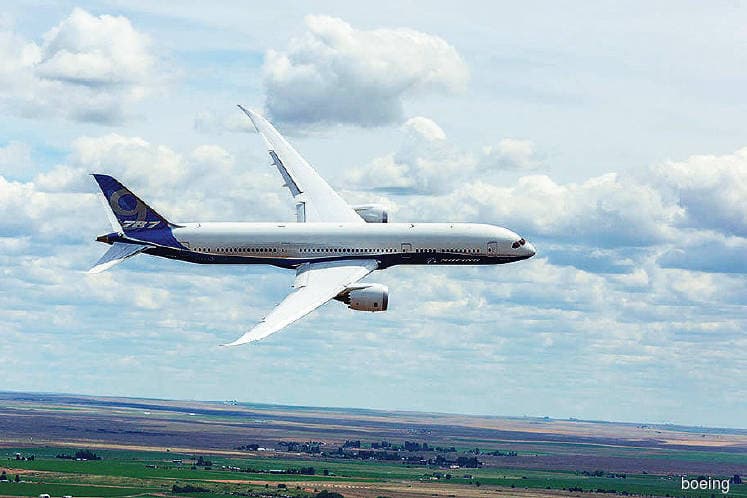
This article first appeared in The Edge Malaysia Weekly on September 18, 2017 - September 24, 2017
LAST week, Malaysia Airlines placed an order with Boeing Co that included eight 787-9 Dreamliners worth US$2.2 billion at list prices. The move is seen as part of the national carrier’s broader plans to modernise its fleet by replacing its older aircraft over the next few years.
Peter Bellew, managing director and CEO of Malaysia Airlines, had previously said the airline was looking to buy as many as 25 wide-body aircraft by year-end.
However, not everybody is thrilled. Critics are questioning why the loss-making airline is buying the bigger and pricier Dreamliners if it is focusing on the intra-Asia routes, which can be served by narrow-body single-aisle planes. Some even speculate that Malaysia Airlines is flip-flopping on its five-year recovery plan and wants to restart the long haul routes that were cut as part of its revamp plan.
The last thing the Malaysian public would want to see is a repeat of poor judgement by the airline and spending taxpayer money to rejuvenate it. In 2003, the airline bought six Airbus A380 jumbo jets and it is now finding it difficult to fill or sell them.
Bellew clarifies that Malaysia Airlines’ focus on intra-Asia travel is still intact. Responding to critics, he says, “The strategy (from 2014) to 2019 continues to focus on Asia, Australia, New Zealand, India and the Middle East. But you need a high quality plane with good economics and the 787-9 is proving a great success for other airlines flying to Kuala Lumpur.”
“For the longer term — and you have to think that way in aviation — the 787-9 can operate anywhere that the airline would wish and it gives complete flexibility at a great price. There is strong demand from KL for direct services to big global capitals that is not being serviced now. This may create profitable opportunities for Malaysia Airlines in the future and this plane can service that while cost effectively giving great service in our current market,” Bellew tells The Edge via email.
“The (Dreamliner) aircraft has great economics, huge flexibility and a tremendous passenger comfort. (These aircraft) operate regularly now from KL to Japan and the Middle East and passengers will expect the very best from Malaysia Airlines in the next decade.”
Current customers of the Dreamliners include Singapore Airlines, WestJet Airlines, Qatar Airways, All Nippon Airways and Qantas.
Bellew had told The Edge in an interview in May that its fleet of 737-800s was too small to serve its routes. “The only change to [our original] plan is that we have decided to swap our narrow-body planes with wide-body aircraft so that our overall fleet size would not grow significantly. However, a wide-body aircraft would give us some extra seats and a better product,” he explained.
The latest order will see Malaysia Airlines converting eight of a previous firm order of 25 Boeing 737 jets reached last year into orders for the Dreamliners, plus the right to buy eight more 737 MAX 8 single-aisle jets.
“The [new] aircraft are initially planned to operate services in Asia, Australia and New Zealand and address the end of lease of some existing A330 wide-body jets in our fleet. There is no immediate plan to operate long haul routes, but the aircraft give complete flexibility to do any mission required over the next 12 years,” says Bellew.
Malaysia Airlines had also considered buying the Airbus A330neo jets, which directly compete with Boeing’s Dreamliners, before settling on the 787-9. To this, Bellew says the airline is not stopping at the eight Dreamliners order.
“We will require more wide-body aircraft. We are evaluating second-hand quality aircraft, new A330neos and more 787-9s. It will all be timed around getting the best value for money deal and the right delivery dates,” he adds.
On how Malaysia Airlines will finance its latest aircraft purchases, he says, “They will be purchased direct from Boeing and a series of sale and lease back contracts, generally of 12 years, will be done with large international leasing companies. We have already discussed this with lessors and the market is very active for 787-9s.”
In 2014, Malaysia Airlines’ parent Khazanah Nasional Bhd had injected investments totalling RM6 billion to support the airline’s five-year recovery plan.
In announcing its second-quarter 2017 results on Sept 8, Malaysia Airlines said it was still on track to be profitable in 2018.
A check with the Companies Commission of Malaysia reveals that Malaysia Airlines, which is not listed, narrowed its net loss to RM438.87 million in the financial year ended Dec 31, 2016 (FY2016) from RM1.13 billion in FY2015. Revenue rose 2.7 times to RM8.57 billion in FY2016 from RM3.14 billion the previous year.
Save by subscribing to us for your print and/or digital copy.
P/S: The Edge is also available on Apple's AppStore and Androids' Google Play.